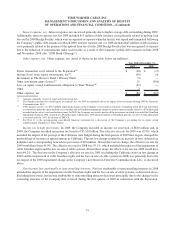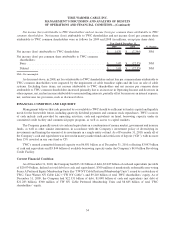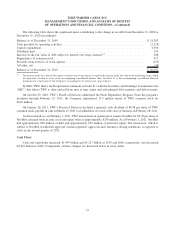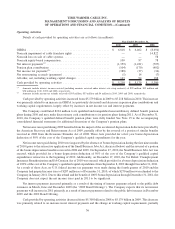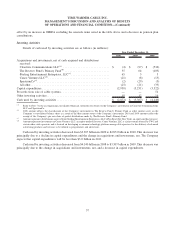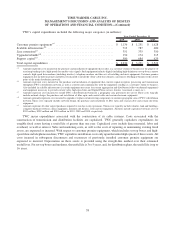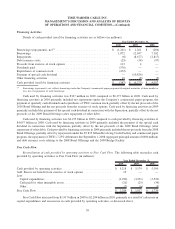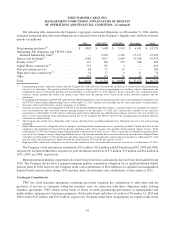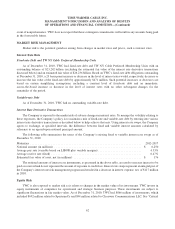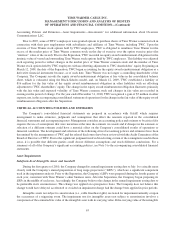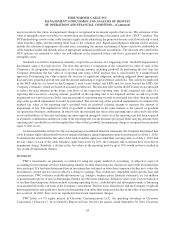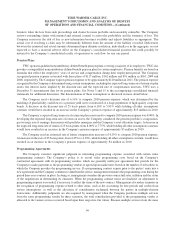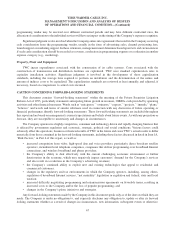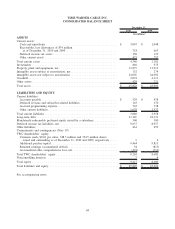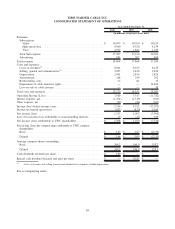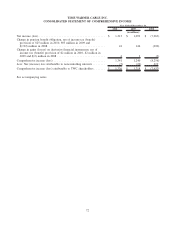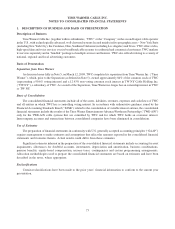Time Warner Cable 2010 Annual Report Download - page 75
Download and view the complete annual report
Please find page 75 of the 2010 Time Warner Cable annual report below. You can navigate through the pages in the report by either clicking on the pages listed below, or by using the keyword search tool below to find specific information within the annual report.Accounting Policies and Estimates—Asset Impairments—Investments” for additional information about Clearwire
Communications LLC.
Prior to 2007, some of TWC’s employees were granted options to purchase shares of Time Warner common stock in
connection with their past employment with subsidiaries and affiliates of Time Warner, including TWC. Upon the
exercise of Time Warner stock options held by TWC employees, TWC is obligated to reimburse Time Warner for the
excess of the market price of Time Warner common stock on the day of exercise over the option exercise price (the
“intrinsic” value of the award). Prior to the Separation, TWC recorded an equity award reimbursement obligation for the
intrinsic value of vested and outstanding Time Warner stock options held by TWC employees. This liability was adjusted
each reporting period to reflect changes in the market price of Time Warner common stock and the number of Time
Warner stock options held by TWC employees with an offsetting adjustment to TWC shareholders’ equity. Beginning on
March 12, 2009, the date of the Separation, TWC began accounting for the equity award reimbursement obligation as a
derivative financial instrument because, as of such date, Time Warner was no longer a controlling shareholder of the
Company. The Company records the equity award reimbursement obligation at fair value in the consolidated balance
sheet, which is estimated using the Black-Scholes model, and, on March 12, 2009, TWC established a liability of
$16 million for the fair value of the equity award reimbursement obligation in other liabilities with an offsetting
adjustment to TWC shareholders’ equity. The change in the equity award reimbursement obligation fluctuates primarily
with the fair value and expected volatility of Time Warner common stock and changes in fair value are recorded in
earnings in the period of change. For the year ended December 31, 2010, TWC recognized a gain of $5 million in other
expense, net, in the accompanying consolidated statement of operations for the change in the fair value of the equity award
reimbursement obligation after the Separation.
CRITICAL ACCOUNTING POLICIES AND ESTIMATES
The Company’s consolidated financial statements are prepared in accordance with GAAP, which requires
management to make estimates, judgments and assumptions that affect the amounts reported in the consolidated
financial statements and accompanying notes. Management considers an accounting policy and estimate to be critical if it
requires the use of assumptions that were uncertain at the time the estimate was made and if changes in the estimate or
selection of a different estimate could have a material effect on the Company’s consolidated results of operations or
financial condition. The development and selection of the following critical accounting policies and estimates have been
determined by the management of TWC and the related disclosures have been reviewed with the Audit Committee of the
Board of Directors of TWC. Due to the significant judgment involved in selecting certain of the assumptions used in these
areas, it is possible that different parties could choose different assumptions and reach different conclusions. For a
summary of all of the Company’s significant accounting policies, see Note 3 to the accompanying consolidated financial
statements.
Asset Impairments
Indefinite-lived Intangible Assets and Goodwill
During the first quarter of 2010, the Company changed its annual impairment testing date to July 1 to coincide more
closely with the Company’s annual preparation of long range projections (“LRPs”), which are a significant component
used in the impairment analysis. Prior to the Separation, the Company’s LRPs were prepared during the fourth quarter of
each year, consistent with Time Warner’s other business units. After the Separation, the Company began preparing its
LRPs in the middle of each year. Accordingly, the Company believes the change in the annual impairment testing date to
be preferable in its circumstances. This change was applied on a prospective basis. The Company does not believe this
change would have delayed, accelerated or avoided an impairment charge had the change been applied in prior periods.
Intangible assets not subject to amortization (i.e., cable franchise rights) are tested for impairment annually or upon
the occurrence of a triggering event. The impairment test for intangible assets not subject to amortization involves a
comparison of the estimated fair value of the intangible asset with its carrying value. If the carrying value of the intangible
63
TIME WARNER CABLE INC.
MANAGEMENT’S DISCUSSION AND ANALYSIS OF RESULTS
OF OPERATIONS AND FINANCIAL CONDITION—(Continued)


